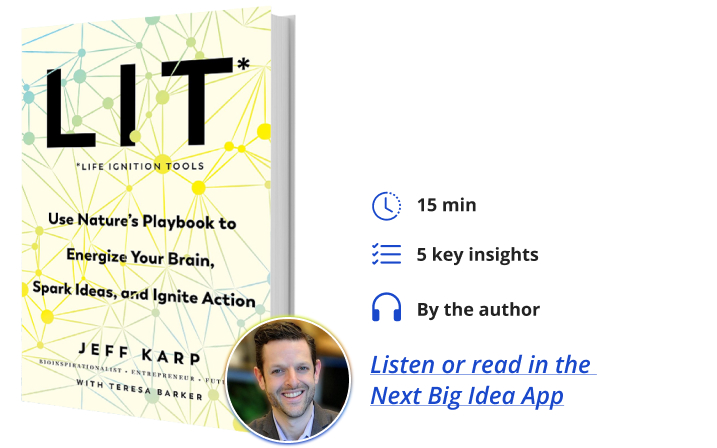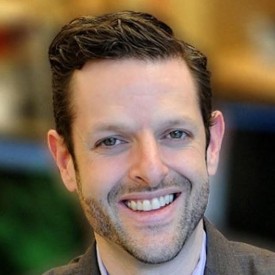Jeff Karp is a renowned biomedical engineer and innovator known for his work at MIT and Harvard. He has led groundbreaking research in biomedical engineering, creating solutions to various medical challenges. Karp’s work is influenced by his personal experiences with ADHD and his deep connection to nature, which have shaped his unique approach to problem-solving and innovation.
Below, Jeff shares five key insights from his new book, LIT: Life Ignition Tools: Use Nature’s Playbook to Energize Your Brain, Spark Ideas, and Ignite Action. Listen to the audio version—read by Jeff himself—in the Next Big Idea App.

1. These tools are road-tested. They come from the lab of my own life.
As a kid, I used to sit in the back of my 2nd-grade classroom without a clue as to what was going on. I struggled to follow along. The teachers called me “lazy” and a “troublemaker.” It was pretty rough. I felt frustrated and totally demoralized. My mom tried everything: phonics flashcards — you name it. But it just wasn’t working. It got so bad that the school wanted to hold me back. One fateful day in summer school that year, I had an epiphany that became the underlying basis of all the tools in the LIT toolkit. The tutor asked me a question which I answered. Then she said, “Jeff, how did you think about that?” It blew my mind. It had never occurred to me that you could think about thinking. It was almost like the roof came off, and whoosh—suddenly there were no limits. There was an empty canvas and a freedom. It came from the liberating notion that you could observe your thoughts and think before speaking, before doing! It shifted the ground under my feet.
Turns out the reason I couldn’t follow along in class was because I had ADHD and other learning differences. The diagnosis certainly helped, but it didn’t make it go away. Where most people see one solution to a problem, I could see a dozen possibilities. I needed to be able to focus and self-regulate. Over the span of my entire childhood, I started to discover and utilize key tools that allowed me to enter into a flow state like never before. The result? I went from D’s to straight A’s. My productivity and efficiency shot up.
For a while, it worked wonders. Using these LIT tools, this kid who was once labeled a lost cause got all the way into a biomedical engineering lab at MIT under my mentor, the legendary innovator Bob Langer. That was the springboard for opening my own research lab at Harvard, where we are fortunate enough to do work that we love, innovating solutions to all kinds of biomedical problems, helping patients and doctors. But being so laser-focused on work and productivity took its toll. At my kids’ birthday parties, I would scan the room to network. I’d take my kids to their soccer practices, and instead of watching them, I’d just walk around in circles to make sure I hit my ten thousand steps. Then, when COVID hit, reality came crashing down right in my living room. I realized that, over the years, I had become utterly disconnected from my family. My kids weren’t coming to me anymore. It sounds like a Hollywood cliché, but it really happened. It felt like overnight my son had turned into a young man and the captain of a football team, and I missed it. And I didn’t want to miss anything anymore. I needed to repair that.
So, I further refined the tools and tried them out in different ways. They were no longer about productivity alone but married to a sense of deep curiosity and purpose. These tools that were once just survival tools have become something much greater. By constantly experimenting in my own life, I can report to you wholeheartedly that using these tools has opened up an entire world that’s brimming with a feeling of awe, humility, gratitude, and profound creativity — and aliveness—as I’ve never had access to before.
And the best part is they belong to you. They belong to everyone. How do I know? I spoke with forty amazing individuals – from Nobel laureates to world champions to scientists and celebrated artists and indigenous leaders who testify to the universal nature of these tools. This is one case where I can say I’m so glad I was the test subject.
2. Neurodiversity is your superpower.
There’s a scene in one of the Terminator movies where the Terminator is looking at a screen when multiple windows pop up, and he has to choose one option. He can’t seem to decide. When I first saw that scene, it really jumped out at me. That’s the way I felt all day, every day. Whereas most people would see one possible right answer, I would see a dozen. My mind was splayed like a fan in different directions.
In my childhood days, this posed a major obstacle. Later, I learned that my ADHD was a form of neurodivergence. It was a term coined in the late 90s by an Australian sociologist named Judy Singer — she invented it to recognize that some people have a brain that develops or works differently from the typical brain. In fact, just like snowflakes and fingerprints, no two brains are exactly alike. Even for identical twins. As some scholars have pointed out, neurodiversity is based on the understanding that autism, ADHD, and so on are the result of normal, natural human variation in the human genome.
“Embracing other people’s neurodiversity is equally valuable.”
For the longest time, I thought my neurodiversity was something I thought I was supposed to conquer or eliminate. But as I got older, I realized that accepting it and navigating life through its lens—with the help of the LIT tools I’d developed—brought me all kinds of unexpected gifts. It’s allowed me to deepen my curiosity about everything, made my focus razor-sharp, and increased my capacity to be more reflective and present than I’d ever thought possible. Embracing other people’s neurodiversity is equally valuable.
One day, I got a resume from a young man named Praveen who wanted to apply for a job in my lab. It was pretty impressive, but he was a chemist, and I didn’t really have anything that fit his qualifications. I was about to put the resume down when something caught my eye. At the end of it, there was a series of cartoons! Each cartoon represented one of his major accomplishments. I was intrigued and amazed. Without a single word, he’d managed to convey vital information with the power of his striking images.
Turns out Praveen was a supercommunicator. He was a scientist at heart, but he also had a storyteller gene. He could create images that could impart the essentials of a given science topic; he hosted his own science radio show where he explained key concepts to a general audience. His badminton game wasn’t too sloppy, either. All of this was a neon sign telling me that this guy was hugely creative and his talents served his passions. Even though I didn’t have a project that was a perfect fit — I hired him.
I knew it was important to have creative diversity. We tackle urgent biomedical problems in all kinds of illnesses and diseases. Our team isn’t made up of scientists all from the same background. We’ve assembled the Avengers version where everyone has a different specialty. Heck, in the past, we’ve even hired a dentist. Innovating works better if you have a variety of perspectives. Nearly every big puzzle we’ve solved (that went on to become its own spinoff company) is thanks to a myriad of ways of seeing the puzzle in the first place.
Like a sculptor who creates using clay, Praveen was a chemist who used molecules as his medium. Even without a cape, you could just tell he had superpowers.
3. Nature got itself to the moon.
I know that’s a strange statement, but hear me out. What it means is that nature is not just what we’re connected to but what we truly are. Shifting our identification from separate entities to being part of nature reveals a profound understanding. From a young age, we’re conditioned to see ourselves as individual pieces on a vast chessboard. But glimpses of a deeper connection to the entire game emerge throughout our lives.
For me, this realization began in childhood when we moved to the countryside. Behind our house, a clear creek teemed with crayfish and leeches. Snapping turtles laid their eggs in our backyard, and at night, wolves howled in the nearby fields. School days were exhausting. My undiagnosed learning differences left me struggling. But the tall grove of trees lining our gravel driveway offered solace. I would stand there just staring at the trees, and I felt an embrace that instantly calmed me. It was as if nature was giving me a hug, unraveling the knots of stress and anxiety.
I understood implicitly that nature’s serenity stemmed from a silent recognition—we were made of the same essence. The current of consciousness moving through the trees also flowed through me. Later, I saw how this unity is reflected in our physiology. Just as the natural world is engaged in endless iteration, our brains are malleable, constantly forging new neural connections with every new habit. Knowing this suddenly made sense to my neurodivergent brain! As nature has been evolving and solving problems for millions of years, it is probably the greatest R&D ever. It’s actually what inspired our lab to create a life-saving adhesive heart patch for children undergoing surgery, mimicking the ingenious glue of creatures like snails and sandcastle worms.
“Just as the natural world is engaged in endless iteration, our brains are malleable, constantly forging new neural connections with every new habit.”
While it seems daunting to contemplate such a grand-scale process, there is a simple way to access it within ourselves. On your next walk, focus on cycling through your senses one at a time: sound, sight, smell, and touch. First, just listen. Then just see. Next, just pay attention to the scents in the air. Then touch — say a pebble worn smooth by water or wind and tree bark etched with new growth each year. Feeling those textures formed and distilled over millennia can be a grounding experience.
And yet we also often long to be anywhere but grounded on Earth. Since the dawn of time, humanity has dreamt of reaching the stars. If we see that it’s not just a handful of NASA astronauts that made it to the moon but nature guiding itself into the cosmos, we realize a profound truth. Human achievements, including space exploration, are products of natural processes and evolution. Our ingenuity and technological advancements are extensions of the same natural forces that shaped life on Earth. That simple shift in perspective really would be one giant leap for humankind.
4. Failure is the closest thing to success.
Most people think of failure as the end of the road. No wonder we live in a culture that frowns on failure. Yet the truth is you’ve never been closer to your end goal than when you’ve failed at something. When things go awry, it’s not necessarily a final verdict on your abilities. What would happen, say, if you accepted the setback as a natural part of the larger process of iteration? It’s a game changer.
The power to focus beyond failure is one of the most important life tools that we have. Early in my career, I was chomping at the bit to pursue projects. But to do that, I had to get research grants to support myself, the team, and the lab. Boy, did I learn the hard way that grants don’t fall from trees.
At the start, I submitted over a hundred proposals for funding, and almost all of them were rejected. Every rejection felt like a real gut punch. Things were worse when I let my ego take the reins — I started believing in false ideas like, “the process was unfair” or “they were crazy to reject this.” I was completely absorbed in the indignity of failure. It was gnawing away at me. So much so that I couldn’t eat. I could barely sleep. My wife started asking me if I’d made the right career choice. The pressure was enormous. But then my mentor at MIT, Bob Langer, a humble titan of an innovator, dropped this nugget of wisdom: “It’s the grants you get that count!”
That turned everything around. I was on a mission to discover why my grant proposals weren’t working. I attended lectures and seminars on grant writing. I listened to the advice of peers saying that I needed to include more preliminary data. I paid close attention to the feedback – the proposal didn’t go deep enough, you didn’t show a backup plan, the project was too risky, you didn’t have enough expertise. I learned that each grant submission needed to be “de-risked” by demonstrating that my concept was backed up with data. Eventually, I realized that I wasn’t failing at writing grants; I was being schooled in grantsmanship. The feedback was gold. Instead of wallowing, I looked at every miss as an opportunity to incorporate more insights into the next proposal. Finally, our lab won three sizable grants, which gave us the security to move forward.
“The power to focus beyond failure is one of the most important life tools that we have.”
Instead of looking at misses as a fixed thing, reflect on it. Sleep on it. Collect new insights and bring those to your next iteration. It’ll drain the fear and bring on the growth that you need to tackle even bigger mountains. Seeing it as a natural evolution of your plan — a 2.0, a 3.0, and a 4.0 — will not only get you to the finish line but it will open up your world in a way.
5. Don’t be an expert, be a beginner.
When we operate out of a sense of separateness, our lives can become overwhelmed with frustration, disappointment, resentment, and everyday desires and fears. Usually, that happens when we believe — falsely — that what makes us who we are is what we have or what we know or what we do. But what if we dropped our identity as the expert, as the someone who knows how to do it “the right way,” the one that has been accumulating knowledge over a lifetime until it hardens into a dogma until we can’t see anything new anymore? What if, instead, we tap into our deep reservoir of humility?
Cue the record scratch.
We re-sensitize our aliveness! Without even trying, we will be AWED by the smallest things, grateful for everything, curious and free from our old preconceived notions and the chokehold of our own opinions. Like the Zen tradition of “Beginner’s Mind,” we will awaken to the freshness inside every moment. As the famous line goes, “In the beginner’s mind, there are many possibilities; in the expert’s, there are few.” Receptive and wide-open, we can learn new skills, express more empathy, be more curious, feel less judgment and consequently less stress when things don’t go our way. We can take inspiration from children who possess an uncanny willingness to learn and explore.
Lynn Twist had to find those childhood roots. As co-founder of a non-profit that partners with indigenous people in the Amazon, she came into the Amazon with assumptions; she would run things the way she always had with her past projects in Africa. When she arrived, she discovered to her surprise that these communities were neither impoverished nor hungry, nor did the indigenous women subscribe to the Western views of their roles. “I learned that whatever I think about what they could be doing is not even helpful. It’s what THEY see the opening is for them. It’s not about giving to the “have-nots.” These are women who know the territory and know what their needs are.” Learning to listen was essential to doing the work that really mattered.
So let’s take a cue from our kids—there’s so much to gain from letting go of our know-it-all selves.
To listen to the audio version read by author Jeff Karp, download the Next Big Idea App today:































